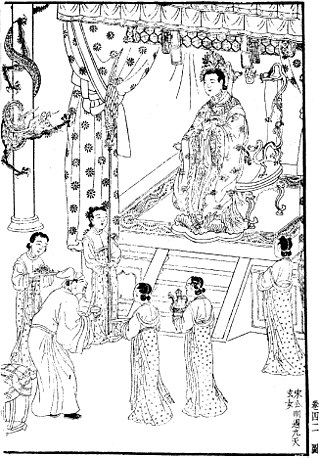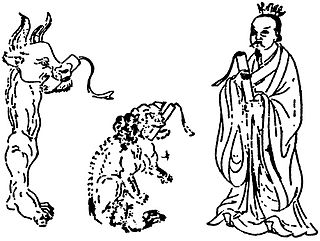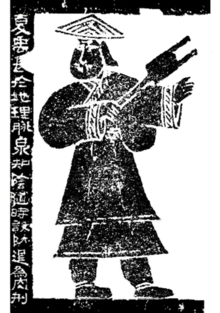
Japanese calendar types have included a range of official and unofficial systems. At present, Japan uses the Gregorian calendar together with year designations stating the year of the reign of the current Emperor. The written form starts with the year, then the month and finally the day, coinciding with the ISO 8601 standard.
The sexagenary cycle, also known as the ganzhi or stems-and-branches is a cycle of sixty terms, each corresponding to one year, thus a total of sixty years for one cycle, historically used for recording time in China and the rest of the East Asian cultural sphere and Southeast Asia. It appears as a means of recording days in the first Chinese written texts, the oracle bones of the late second millennium BC Shang dynasty. Its use to record years began around the middle of the 3rd century BC. The cycle and its variations have been an important part of the traditional calendrical systems in Chinese-influenced Asian states and territories, particularly those of Japan, Korea, and Vietnam, with the old Chinese system still in use in Taiwan, and in Mainland China. In India, the Ahom people also used the sexagenary cycle known as Lak-Ni.

Yu the Great or Yu the Engineer was a legendary king in ancient China who was credited with "the first successful state efforts at flood control", his establishment of the Xia dynasty, which inaugurated dynastic rule in China, and for his upright moral character. He figures prominently in the Chinese legend titled "Great Yu Controls the Waters". Yu and other sage-kings of ancient China were lauded for their virtues and morals by Confucius and other Chinese teachers. He is one of the few Chinese monarchs who is posthumously honored with the epithet "the Great".

Jiutian Xuannü is the goddess of war, sex, and longevity in Chinese mythology. The swordswoman Yuenü is a reincarnation of Jiutian Xuannü.
The Four Pillars of Destiny, as known as "Ba-Zi", which means "eight characters" or "eight words" in Chinese, is a Chinese astrological concept that a person's destiny or fate can be divined by the two sexagenary cycle characters assigned to their birth year, month, day, and hour. This type of cosmological astrology is also widely used in South Korea, Japan and Vietnam.

In Chinese philosophy, wuji originally referred to infinity. In Neo-Confucian cosmology, it came to mean the "primordial universe" prior to the "Supreme Ultimate" state of being.

Da Liu Ren is a form of Chinese calendrical astrology dating from the later Warring States period. It is also a member of the Three Styles of divination, along with Qi Men Dun Jia (奇門遁甲) and Taiyi (太乙).
Gun, also known as Count of Chong, is a figure in Chinese mythology, sometimes noted as the father of Yu the Great, the founder of the Xia dynasty. Gun was appointed to the task of controlling the Great Flood by Emperor Yao on the advice of the Four Mountains. Gun used dykes to try to stop the flooding but the dykes collapsed, killing many people.
The Chu Silk Manuscript, also known as the Chu Silk Manuscript from Zidanku in Changsha, is a Chinese astrological and astronomical text. It was discovered in a Warring States period tomb from the southern Chinese state of Chu.
The Nine Tripod Cauldrons were, a collection of ding in ancient China that were viewed as symbols of the authority given to the ruler by the Mandate of Heaven. According to the legend, they were cast by Yu the Great of the Xia dynasty.
Fangshi were Chinese technical specialists who flourished from the third century BCE to the fifth century CE. English translations of fangshi include alchemist, astrologer, diviner, exorcist, geomancer, doctor, magician, monk, mystic, necromancer, occultist, omenologist, physician, physiognomist, technician, technologist, thaumaturge, and wizard.
Shuanggudui is an archeological site located near Fuyang in China's Anhui province. Shuanggudui grave no. 1, which belongs to Xiahou Zao (夏侯灶), the second marquis of Ruyin (汝陰侯), was sealed in 165 BCE in the early Han dynasty. Excavated in 1977, it was found to contain a large number of texts written on bamboo strips, including fragments of the Classic of Poetry and the Songs of the South, a text on breathing exercises, a "year table" (年表) recounting historical events, a manual on dogs, a version of the I Ching (Yijing) that differs from the received one, and artifacts including the oldest known cosmic board, a divinatory instrument. Like Mawangdui and Guodian, two other tombs from the area of the old state of Chu, the Shuanggudui find has shed great light on the culture and practices of the early Han dynasty.
Deng Yang, courtesy name Xuanmao, was an official of the state of Cao Wei in the Three Kingdoms period of China.

Yubu, translated as Pace(s) of Yu or Step(s) of Yu, is the basic mystic dance step of religious Daoism. This ancient walking or dancing technique typically involves dragging one foot after another, and is explained in reference to the legendary Yu the Great, who became lame on one side of his body from exerting himself while establishing order in the world after the Great Flood. Daoist religions, especially during the Six Dynasties period (220–589), incorporated Yubu into rituals, such as the Bugang 步罡 "pace the Big Dipper", in which a Taoist priest would symbolically walk the nine stars of the Beidou 北斗 "Big Dipper" in order to acquire that constellation's supernatural energy.
Bugang is a Daoist ritual dance or walk, based upon the Yubu "Steps of Yu" tradition, in which a Taoist priest paces through a supernatural pattern, such as stars in the Big Dipper or numbers in the Loshu magic square. Texts from the Shangqing School revelations contain the earliest descriptions of bugang, frequently with the practitioner pacing among constellations, especially the Big Dipper's stars. When religious Daoism began during the Six Dynasties period, the expression bugang tadou 步罡踏斗 "pacing the guideline and treading on the Dipper" became popular.
Bianhua, meaning 'transformation' or 'metamorphosis', was a keyword developed in both Daoism and Chinese Buddhism. Daoists used bianhua describing things transforming from one type to another, such as from a caterpillar to a butterfly. Buddhist translators used bianhua for Sanskrit nirmāṇa 'manifest through transformations', such as the nirmāṇa-kaya 'transformation body' of a Buddha's reincarnations.

The sanshi 三尸 "Three Corpses" or sanchong 三蟲 "Three Worms" are a Daoist physiological belief that demonic creatures live inside the human body, and they seek to hasten the death of their host. These three supernatural parasites allegedly enter the person at birth, and reside in the three dantian "energy centers", respectively located within the head, chest, and abdomen. After their human host dies, they are freed from the body and become malevolent ghosts.

Shijie, which has numerous translations such as liberation from the corpse and release by means of a corpse, is an esoteric Daoist technique for an adept to transform into a xian, typically using some bureaucratic ruse to evade the netherworld administrative system of life and death registration. The many varieties of shijie range from deceitful cases, such as a person feigning death by substituting the corpse of their recently deceased grandfather as their own, to supernatural cases, such as using a waidan alchemical sword to temporarily create a corpse-simulacrum, which enables one to escape and assume a new identity.

Chu is a Daoist name used for various religious practices including communal chu (Kitchen) banquet rituals in Way of the Celestial Masters liturgy, the legendary xingchu associated with Daoist xian, and wuchu representing the wuzang in neidan meditation techniques.

A lunary, also called a selenodromion or moonbook, is a book of prognostication based on the position of the moon at any given time. It is an astrological genre with parallels as far back as Akkadian literature. From the 2nd century AD, it is common in the Greco-Roman world. There are examples in Greek, Latin, Coptic, Middle English and Old Nubian. Pagan, Jewish and Christian examples are known. The lunary was "by far the most popular and widely circulated prognostic genre" during the Middle Ages.











